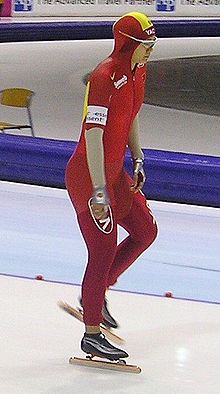Long-track speed skating
Long-track speed skating enjoys large popularity in the Netherlands and has also had champion athletes from Austria, Canada, China, Finland, Germany, Japan, Italy, Norway, Poland, South Korea, Russia, Sweden, the Czech Republic and the United States.The roots of speed skating date back over a millennium to Scandinavia, Northern Europe and the Netherlands, where the natives added bones to their shoes and used them to travel on frozen rivers, canals and lakes.While in the Netherlands, people began touring the waterways connecting the 11 cities of Friesland, a challenge which eventually led to the Elfstedentocht.[1] The Elfstedentocht (Eleven Cities Tour) was organised as a competition in 1909 and has been held at irregular intervals whenever the ice on the course is deemed good enough.Charles Jewtraw from Lake Placid, New York, won the first Olympic gold medal, though several Norwegians in attendance claimed Oskar Olsen had clocked a better time.The ISU approved the suggestion that the 1932 Olympic speed skating competitions should be held as pack-style races, and Americans won all four gold medals.Canada won five medals, all silver and bronze, while defending World Champion Clas Thunberg stayed at home, protesting against this form of racing.[5] At the World Championships held immediately after the Games, without the American champions, Norwegian racers won all four distances and occupied the top three spots in the allround standings.Norwegian, Swedish, Finnish and Japanese skating leaders protested to the USOC, condemning the manner of competition, and expressing the wish that mass start races were never to be held again at the Olympics.However, ISU adopted the short-track speed skating branch, with mass start races on shorter tracks, in 1967, arranged international competitions from 1976, and brought them back to the Olympics in 1992.Although women's races had been held in North America for some time and competed at the 1932 Winter Olympics in a demonstration event, the ISU did not organise official competitions until 1936.Jonny Nilsson, 1963 world champion and Olympic gold medallist, was the driving force behind the league, which folded in 1974 for economic reasons, and ISU also excluded tracks hosting professional races from future international championships.[7] The ISU later organised its own World Cup circuit with monetary prizes, and full-time professional teams developed in the Netherlands during the 1990s, which led them to a dominance on the men's side only challenged by Japanese 500 m racers and a couple of American allrounders.Occasionally, quartet starts are used, for the pragmatic and practical reason of allowing more skaters to complete their races inside a given amount of time.The high altitude is believed to be part of the reason that the 2002 Salt Lake City games broke most of the previous speed-skating Olympic records.[14] In Norway there is an agreement in place, stating that an indoor arena intended primarily for either bandy or long-track speed skating, shall have ice surface for the other sport as well.They were considered revolutionary as the blades are hinged at the front of the boot and detach at the heel, allowing the skater a more natural range of movement.In cold winters in the Netherlands, a "National championship" skating marathon on natural ice is organized if it meets the minimum requirement of 12-centimetre thickness.For the first time in 13 years, a Dutch championship ice-skating marathon on natural ice was held in January 2009, in the Oostvaardersplassen wetland near Lelystad in the province of Flevoland, an area of land reclaimed in the 1960s.As its inclusion would place the athletes who have been active before 1996 at a significant disadvantage, World Single Distance Championships are not included as a primary component of the list, though individual achievements in that competition are noted when applicable.The team pursuit, introduced at the 2006 Olympics and the 2005 World Single Distance Championships, has been left out for a more balanced comparison and to focus on individual achievements.







Speed skatingShannon Rempelgoverning bodyInternational Skating UnionMixed-sexOlympicOlympic disciplineice skating marathonshort-track speedskatinginline speedskatingquad speed skatingNetherlandsAustriaCanadaFinlandGermanyNorwayPolandSouth KoreaRussiaSwedenCzech RepublicUnited StatesJaap EdenguineasElfstedentochtSlikkerveerNRC HandelsbladSpeed skating at the Winter Olympics1916 Olympicsfigure skatingWorld War IChamonixCharles JewtrawLake Placid, New YorkOskar OlsenIvar BallangrudClas Thunberg1932 Olympic speed skating competitionsZofia NehringowaEast Germanyreunified1960 Winter OlympicsLake MisurinaLidia SkoblikovaFranz Krienbühlclap skateArd SchenkJonny NilssonSpeed skating rinkathletics trackBislett stadionErfurtHeilongjiang Indoor RinkHarbinChangchunKolomnaIce Palace KrylatskoyeMoscowM-WaveNaganoLudwig Schwabl StadionInzellOval LingottoOlympic OvalCalgaryPettit National Ice CenterWest Allis, WisconsinRichmond Olympic OvalRichmond, British ColumbiaSportforum HohenschönhausenBerlinThialfHeerenveenUtah Olympic OvalKearns, UtahVikingskipetAlau Ice PalaceNur-SultanQuébec CityQuébecKlobenstein–CollalboKazakhstanHamar Olympic HallBeijing National Speed Skating Oval2022 Winter OlympicsFederation of International Bandyice skatesclap skates1998 Winter Olympicsice skatingair resistanceturbulent flowtruncationsamalogViktor KosichkinRolf Falk-LarssenTomas GustafsonWorld Allround Speed Skating ChampionshipsWorld Sprint Speedskating ChampionshipsEuropean Allround Speedskating ChampionshipsWorld Single Distance ChampionshipsWorld CupSpeed Skating World CupWouter olde HeuvelErben WennemarsSven Kramerteam pursuittrack cyclingice rinkmarathonNational championshipOostvaardersplassenLelystadFlevolandInternational Big Rideau Lake Speed Skating MarathonPortland, OntarioOlympic Winter GamesWorld All-Round Speed Skating ChampionshipsWorld Sprint Speed Skating ChampionshipsEric HeidenJohann Olav KossIgor ZhelezovskiBelarusHjalmar AndersenShani Davis
